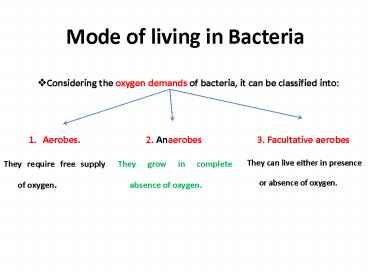Mode of living in Bacteria - PowerPoint PPT Presentation
Title:
Mode of living in Bacteria
Description:
They can build up complex organic substances such as carbohydrates from simple inorganic sources ... animals of humans. They can live on such compounds , ... – PowerPoint PPT presentation
Number of Views:61
Avg rating:3.0/5.0
Title: Mode of living in Bacteria
1
Mode of living in Bacteria
- Considering the oxygen demands of bacteria, it
can be classified into
- Aerobes.
- They require free supply of oxygen.
- 2. Anaerobes
- They grow in complete absence of oxygen.
- 3. Facultative aerobes
- They can live either in presence or absence of
oxygen.
2
Mode of living in Bacteria
- If we consider the mode of nutrition, bacteria
can be divided into two categories - 1. Autotrophs. They can build up complex organic
substances such as carbohydrates from simple
inorganic sources (CO2 and water). - 2. Heterotrophs. They cannot build up
carbohydrates from simple inorganic sources. They
depend on ready made organic materials derived
from plants , animals of humans. They can live on
such compounds , break it down , enzymatically ,
into simpler compounds which can be absorbed. The
process of break down of such complex organic
substances releases energy which can be used by
such bacteria in building up its complex
protoplasmic material from the simple absorbed
substances.
3
I Autotrophic Bacteria
- The autotrophs can be divided into two types
- I Photoautotrophs II
Chemoautotrophs.
4
Autotrophic Bacteria
- Photoautotrophs.
- They contain in their cells a chlorophyll
known as bacterial chlorophyll by which they can
perform photosynthesis. Here, the energy used in
building up processes is derived from light. As
an example of such bacteria is the green sulphur
bacteria. - Light Energy
- 6CO2 12 H2S
C6H12O6 6 H2O 12 S - Green sulphur bacteria
5
Autotrophic Bacteria
- B. Chemoautotrophs. Here the cells lack
chlorophll. Accordingly the source of energy
should be something else than light. The energy
used here is released from chemical reactions
carried out by such bacteria. Most of such
reactions are oxidative.
6
Autotrophic Bacteria (Chemoautotrophs)
- Three examples we have
- 1) Nitrosomonas, oxidizes ammonia or ammonium
salts to nitrites with a release of energy - 2NH3 3O2
2 HNO2 2H2o Energy - 2) Nitrobacter, oxidizes nitrites to nitrates
with a release of energy - 2HNO2 O2
2 HNO3 Energy - 3)Thiobacillus thiooxidans, oxidizes sulphur with
a release of energy - 2S 3O2 2H2O
2 H2SO4 Energy - The energy released from any of these oxidation
reactions is utilized by the specific organism in
building up organic carbohydrates from the simple
inorganic sources, CO2 and water.
7
II. Heterotrophic Bacteria
- Heterotrophs live either as
Saprophytes on dead organic matter.
Parasites on plants, animals and humans causing
serious diseases.
Symbionts with other living organisms sharing
benefit, e.g. Rhizobium (nodule bacteria)
which lives in symbiosis with the roots of
legumes forming root nodules. It can fix
nitrogen and build proteins and other nitrogenous
compounds to be partially delivered, to the
higher plant and get in return the carbohydrates
from the latter.































